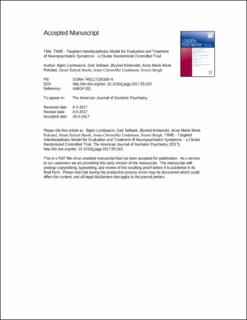Targeted interdisciplinary model for evaluation and treatment of neuropsychiatric symptoms : a cluster randomized controlled trial
Lichtwarck, Bjørn; Selbæk, Geir; Kirkevold, Øyvind; Rokstad, Anne Marie Mork; Saltyte Benth, Jurate; Lindstrøm, Jonas Christoffer; Bergh, Sverre
Peer reviewed, Journal article
Accepted version
Permanent lenke
https://hdl.handle.net/11250/3026712Utgivelsesdato
2018Metadata
Vis full innførselSamlinger
- Artikler [412]
- Publikasjoner fra Cristin [429]
Originalversjon
The American journal of geriatric psychiatry. 2018, 26 (1), 25-38. 10.1016/j.jagp.2017.05.015Sammendrag
Objective To determine the effectiveness of the Targeted Interdisciplinary Model for Evaluation and Treatment of Neuropsychiatric Symptoms (TIME) for treatment of moderate to severe agitation in people with dementia. Methods In a single-blinded, cluster randomized controlled trial in 33 nursing homes (clusters) from 20 municipalities in Norway, 229 patients (104 patients in 17 nursing homes and 125 patients in 16 nursing homes) were randomized to an intervention or control group, respectively. The intervention group received TIME, and the control group received a brief education-only intervention. TIME is an interdisciplinary multicomponent intervention and consists of a comprehensive assessment of the patient with the goal to create and put into action a tailored treatment plan. The primary outcome was the between-group difference in change at the agitation/aggression item of the Neuropsychiatric Inventory Nursing Home version between baseline and 8 weeks. Secondary outcomes were the between-group difference in change at the agitation/aggression between baseline and 12 weeks in other neuropsychiatric symptoms, quality of life, and use of psychotropic and analgesic medications between baseline and 8 and 12 weeks. Results A significant between-group difference in reduction of agitation at both 8 weeks (1.1; 95% confidence interval: 0.1–2.1; p = 0.03) and 12 weeks (1.6; 95% confidence interval: 0.6–2.7; p = 0.002) in favor of the TIME intervention was found. Conclusion The implementation of TIME resulted in a significant reduction of agitation among nursing homes patients with dementia. These results should inform training programs for care staff in Norway and internationally.
